John Deere 995 Rotary Platform

Description
- John Deere-designed rotary cutterbar
- Patented diagonally cut module
- Hydraulic cutterbar angle adjustment
- Adjustable impeller conditioning hood
Models
Windrow formation
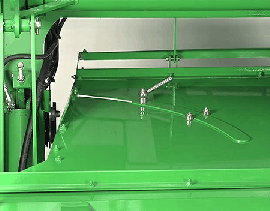 Windrow formation adjustment
Windrow formation adjustment
Forming shields are easily adjusted to control the material flow. This allows the operator to match the windrow width to the harvesting requirements.
The adjustable swathboard controls the angle at which the crop flow contacts the forming shield, providing additional control of windrow formation.
The windrow width is adjustable, without the use of tools, from a narrow windrow to a wide, fast-drying swath:
- 91.4 cm (36 in.) up to 216 cm (85 in.) with the roll conditioner
- 114.3 cm (45 in.) up to 216 cm (85 in.) with the impeller conditioner
NOTE: The windrow width depends on the crop conditions and type of conditioner.
Rotary cutterbar components
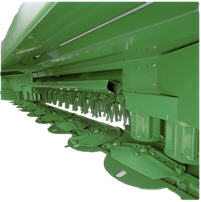 Oval disks with free-swinging knives
Oval disks with free-swinging knives
Large oval disks with free-swinging knives are used to cut the crop.
Knives are free-swinging to reduce damage if a solid object is struck.
-
Knife tip speed is variable and can be adjusted from the cab to improve cutting in light crop conditions
-
Knives are reversible to double useful life
-
Knives are removed and replaced at the front of cutterbar for convenience
- All cutting disks are the same size
- Disks are computer-designed for improved wear and cutting performance
- Cutting disks are made of high-strength, austempered steel
-
Austemper heat-treating process assures that the steel is thoroughly and evenly tempered for good wear characteristics
-
Wear caps
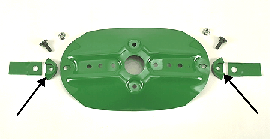 Wear caps
Wear caps
Wear caps are installed on each end of the cutting disks (except on the end disks where crop accelerators are used) to increase the wear life of the cutting disks and knife bolt nuts.
Wear caps are open on the end to prevent debris from packing in close to the nut, making hardware and knives easier to change.
They are made of austempered, heat-treated ductile steel.
Modular-design cutterbar
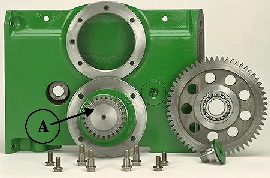 Modular cutterbar
Modular cutterbar
The John Deere-patented-design cutterbar is made from individual, diagonal-cut modules.
Serviceability is easy. Modules can be removed individually while leaving the cutterbar attached to the frame.
The modules are made of high-strength, nodular iron castings. Each module consists of two idler gears and one drive gear. The large-diameter idler gears transmit power from module to module. The idler gears turn at a relatively slow speed for added durability.
A smaller-diameter pinion drive gear is used only to power the cutting disk. Power is not transmitted from one cutting disk to another except through the large-diameter idler gears.
Modules are interchangeable. Disk rotation is determined by the position of the quill (A).
There is a rubber oil seal between each cutting module.
How the impeller conditioner works
The 995 Rotary Platform features a single conditioning option: the impeller conditioner.
Impeller conditioner
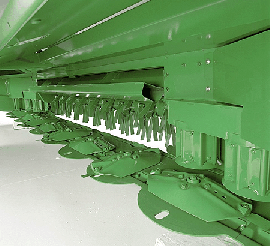 Impeller conditioners
Impeller conditioners
The impeller conditioner works well in a wide variety of crop types and conditions. With proper adjustment, the impeller conditioner delivers a wide range of performance expectations to meet every producer's needs.
How an impeller conditioner works:
1. As hay is cut by rotating knives, 72 V-shaped tines pick up the plants and carry them through the machine. The free-swinging design reduces damage to the conditioner if rocks or other solid objects are struck.
- Tines are evenly spaced along the full width of the rotor
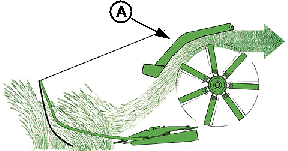 Conditioning hood
Conditioning hood
2. As the plant passes through, it rubs against the conditioning hood (A) and other plants. The rubbing action removes the waxy surface from the stem of the plant to allow faster evaporation of moisture.
3. The conditioner hood is adjustable to control the conditioning intensity. The wider the opening, the less aggressive the conditioning; this is used in legume-type crops. The smaller the opening, the more aggressive the conditioning; this is used more in grass hay.
4. The impeller has two speeds to match crop conditioning requirements:
- Simply interchange the drive sheaves
- High speed of 865 rpm for grass hay
- Low speed of 624 rpm for legumes
The impeller conditioner works well in legumes, especially alfalfa and most all-grass crops. Impeller conditioners are not recommended for cutting thick-stemmed or cane-type crops over 1.5-m (5-ft) tall.
Specifications
- Dimensions - Cutting height: 1.7-17.8 cm<br/>0.7-7 in.
- Dimensions - Cutting width: 5 m<br/>16 ft
- Dimensions - Overall width (transport): 5 m<br/>16.3 ft
- Dimensions - Weight: With impeller conditioner<br/>2,135 kg<br/>4,707 lb<br/>With fluted steel conditioner<br/>2,371 kg<br/>5,229 lb<br/>With urethane conditioner<br/>2,263 kg<br/>4,990 lb<br/>With Tri-Lobe conditioner<br/>2,426 kg<br/>5,350 lb<br/>
- Dimensions - Windrower width (depending on crop conditions): With roll conditioner<br/>91-216 cm<br/>36-85 in.<br/>With impeller conditioner<br/>114-216 cm<br/>45-85 in.<br/>
- Impeller conditioner - Conditioner hood: Adjustable, one lever
- Impeller conditioner - Diameter: 59.4 cm<br/>23.4 in.
- Impeller conditioner - Drive: 4-V powerband belt and sheaves
- Impeller conditioner - No. of speeds: Two-factory setting 624 or 865 rpm<br/>Optional 1,000 rpm
- Impeller conditioner - No. of V-tines: 72
- Impeller conditioner - Width: 2.7 m<br/>8.8 ft
- Key Specs - Compatibility: 4995, R450, W235, W260
- Key Specs - Cutting height: 1.7-17.8 cm<br/>0.7-7 in.
- Key Specs - Cutting width: 5 m<br/>16 ft
- Key Specs - Overall width (transport): 5 m<br/>16.3 ft
- Key Specs - Weight: With fluted steel conditioner<br/>2,371 kg<br/>5,229 lb<br/>With urethane conditioner<br/>2,263 kg<br/>4,990 lb<br/>With Tri-Lobe conditioner<br/>2,426 kg<br/>5,350 lb<br/>
- Rotary disk cutterbar - Guard angle: Adjustable; 0-8 degree (angle)
- Rotary disk cutterbar - Number of disks: 10
- Rotary disk cutterbar - Reservoir capacity: 9.5 L<br/>12 U.S. qt
- Steel conditioner rolls - Diameter: 25.4 cm<br/>10 in.
- Steel conditioner rolls - Drive: Enclosed gear and shaft drive
- Steel conditioner rolls - Material: Steel
- Steel conditioner rolls - Speed: Platform speed 865 at 2,650 rpm
- Steel conditioner rolls - Surface: Intermeshing flutes
- Steel conditioner rolls - Width: 2.7 m<br/>8.8 ft
- Urethane conditioner rolls - Diameter: 25.4 cm<br/>10 in.
- Urethane conditioner rolls - Drive: Enclosed gear and shaft drive
- Urethane conditioner rolls - Material: Urethane
- Urethane conditioner rolls - Speed: Platform speed 865 at 2,650 rpm
- Urethane conditioner rolls - Surface: Intermeshing, intermittent recessed cleats
- Urethane conditioner rolls - Width: 2.7 m<br/>8.8 ft
- Windrower - Compatibility: 4995, R450, W235, W260
- Windrower - Formation: Adjustable fluffboard and adjustable forming shields
Copy Set
Windrow formation
 Windrow formation adjustment
Windrow formation adjustment
Forming shields are easily adjusted to control the material flow. This allows the operator to match the windrow width to the harvesting requirements.
The adjustable swathboard controls the angle at which the crop flow contacts the forming shield, providing additional control of windrow formation.
The windrow width is adjustable, without the use of tools, from a narrow windrow to a wide, fast-drying swath:
- 91.4 cm (36 in.) up to 216 cm (85 in.) with the roll conditioner
- 114.3 cm (45 in.) up to 216 cm (85 in.) with the impeller conditioner
NOTE: The windrow width depends on the crop conditions and type of conditioner.
Rotary cutterbar components
 Oval disks with free-swinging knives
Oval disks with free-swinging knives
Large oval disks with free-swinging knives are used to cut the crop.
Knives are free-swinging to reduce damage if a solid object is struck.
-
Knife tip speed is variable and can be adjusted from the cab to improve cutting in light crop conditions
-
Knives are reversible to double useful life
-
Knives are removed and replaced at the front of cutterbar for convenience
- All cutting disks are the same size
- Disks are computer-designed for improved wear and cutting performance
- Cutting disks are made of high-strength, austempered steel
-
Austemper heat-treating process assures that the steel is thoroughly and evenly tempered for good wear characteristics
-
Wear caps
 Wear caps
Wear caps
Wear caps are installed on each end of the cutting disks (except on the end disks where crop accelerators are used) to increase the wear life of the cutting disks and knife bolt nuts.
Wear caps are open on the end to prevent debris from packing in close to the nut, making hardware and knives easier to change.
They are made of austempered, heat-treated ductile steel.
Modular-design cutterbar
 Modular cutterbar
Modular cutterbar
The John Deere-patented-design cutterbar is made from individual, diagonal-cut modules.
Serviceability is easy. Modules can be removed individually while leaving the cutterbar attached to the frame.
The modules are made of high-strength, nodular iron castings. Each module consists of two idler gears and one drive gear. The large-diameter idler gears transmit power from module to module. The idler gears turn at a relatively slow speed for added durability.
A smaller-diameter pinion drive gear is used only to power the cutting disk. Power is not transmitted from one cutting disk to another except through the large-diameter idler gears.
Modules are interchangeable. Disk rotation is determined by the position of the quill (A).
There is a rubber oil seal between each cutting module.
How the impeller conditioner works
The 995 Rotary Platform features a single conditioning option: the impeller conditioner.
Impeller conditioner
 Impeller conditioners
Impeller conditioners
The impeller conditioner works well in a wide variety of crop types and conditions. With proper adjustment, the impeller conditioner delivers a wide range of performance expectations to meet every producer's needs.
How an impeller conditioner works:
1. As hay is cut by rotating knives, 72 V-shaped tines pick up the plants and carry them through the machine. The free-swinging design reduces damage to the conditioner if rocks or other solid objects are struck.
- Tines are evenly spaced along the full width of the rotor
 Conditioning hood
Conditioning hood
2. As the plant passes through, it rubs against the conditioning hood (A) and other plants. The rubbing action removes the waxy surface from the stem of the plant to allow faster evaporation of moisture.
3. The conditioner hood is adjustable to control the conditioning intensity. The wider the opening, the less aggressive the conditioning; this is used in legume-type crops. The smaller the opening, the more aggressive the conditioning; this is used more in grass hay.
4. The impeller has two speeds to match crop conditioning requirements:
- Simply interchange the drive sheaves
- High speed of 865 rpm for grass hay
- Low speed of 624 rpm for legumes
The impeller conditioner works well in legumes, especially alfalfa and most all-grass crops. Impeller conditioners are not recommended for cutting thick-stemmed or cane-type crops over 1.5-m (5-ft) tall.

